If you’re in the market for new flooring, you may have come across laminate flooring. floating wood tile is a synthetic flooring material that mimics the look and feel of hardwood or stone flooring. It’s an affordable, easy-to-install, and durable option for homeowners. In this comprehensive guide, we will take a closer look at the different types of laminate flooring, as well as the pros and cons, benefits, styles, cost considerations, and installation tips to help you make an informed decision.
What is Laminate Flooring?
Before diving into the various aspects of floating wood tile, it’s important to understand what it actually is. floating wood tile is a synthetic flooring material that resembles hardwood or stone. It consists of multiple layers that are fused, with the top layer featuring a high-resolution photograph of the desired look and texture. This layer is then protected by a clear protective layer, making it durable and resistant to scratches and stains.
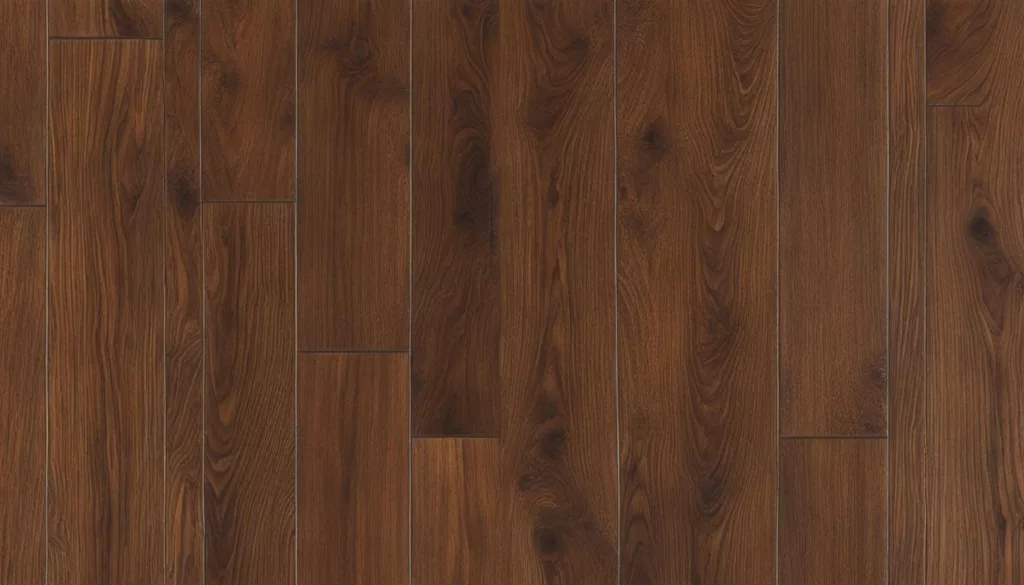
Laminate flooring is a smart alternative to hardwood or stone flooring but with added resilience and a lower price tag.
How to Choose a Laminate?
Choosing the perfect floating wood tile for your space can be a daunting task, especially with a multitude of styles, colors, and textures to choose from. However, by considering some important factors, you can simplify the selection process and find a laminate floor that meets your needs. The following tips will help you choose the right laminate:
- Think about the room: Consider the purpose and function of the room where you plan to install laminate flooring. Will there be high foot traffic? Will it be exposed to moisture, heat, or direct sunlight? Understanding the room’s characteristics will help you select the appropriate type of floating wood tile that can withstand these conditions.
- Check the thickness: The thickness of the laminate flooring affects its durability and stability. Thicker laminates tend to be more resilient and less prone to bending or warping. Look for laminates that are at least 8mm thick.
- Check the AC rating: The AC rating measures the durability and wear resistance of floating wood tile. It typically ranges from AC1 to AC5, with AC5 being the most robust. Consider your lifestyle, and traffic of the room and accordingly opt for an AC rating appropriate to your use.
- Select the style and color: Laminate flooring comes in a wide range of styles, including wood, stone, and tile patterns. Choose the style that works best for your space and complements your decor. You can select the desired surface structure, and surface finish as per your requirement.
By keeping these tips in mind, you can ensure that you select the right floating wood tile to suit your needs and preferences.

Benefits of Laminate Flooring
Floating wood tile is a practical flooring option that comes with numerous benefits:
- Durability: One of the top benefits of laminate flooring is its durability. The flooring material is scratch-resistant, making it ideal for high-traffic areas. You won’t have to worry about your pets, children, or heavy furniture damaging the floor’s surface.
- Affordability: Another significant advantage of floating wood tile is its affordability. When compared to hardwood, tile, or carpet, laminate is a cost-effective option. You can achieve the same look and feel as other flooring options at a fraction of the cost.
- Versatility in Design: Laminate flooring offers a wide variety of designs, patterns, and textures to choose from, enabling you to match your decor’s style. Whether you desire the look of hardwood, tile, or stone, you can find a laminate option that fits your needs.
- Easy Maintenance: With just a little maintenance, floating wood tile can remain in excellent condition for many years. Regular cleaning and sweeping, along with the use of a damp mop, can help keep the floor looking fresh and clean.
- Resistance to Moisture and Stains: Laminate Flooring is designed to be water-resistant, making it a perfect choice for homes with children or pets. If you spill something on the floor, it will not quickly absorb in, making it easy to clean up. Besides, stains, dirt, and dust can easily be wiped away, leaving a spotless surface.
If you’re looking for a flooring option that is affordable, durable, and versatile, floating wood tile is an attractive choice.
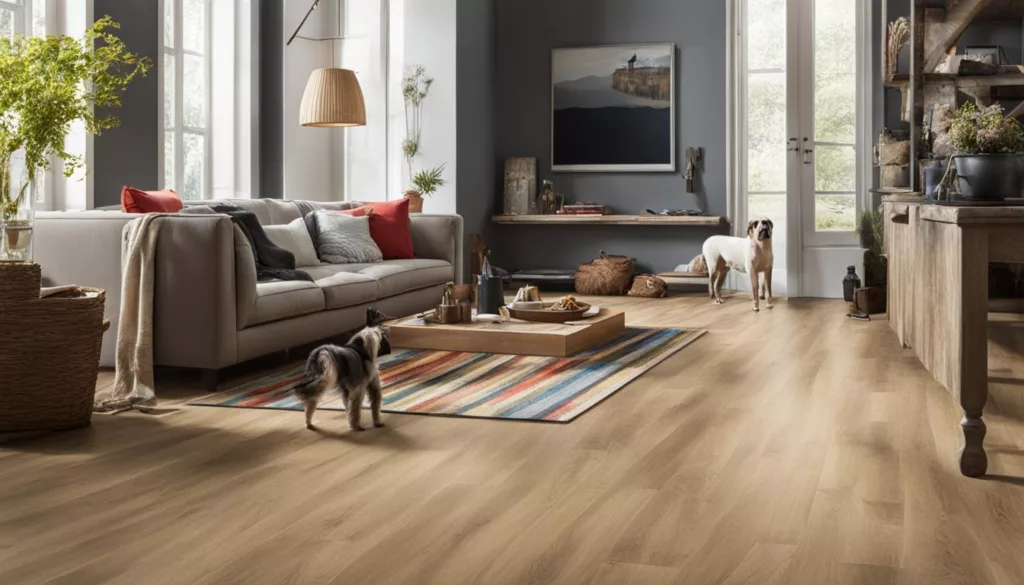
Types of Laminate Flooring for Interior
floating wood tile is a popular choice for interior spaces due to its affordability, durability, and versatile design options. However, with so many types of laminate flooring available, it can be challenging to determine the best fit for your needs. In this section, we will explore different types of floating wood tile and their ideal applications, helping you make an informed decision when selecting flooring for your interior.
Decorative Laminates
Decorative laminates offer various design options, including wood, stone, and tile aesthetics. They consist of a high-resolution image layer that mimics the desired look, which is then protected by a transparent wear layer. Decorative laminates come in different thicknesses and are ideal for high-traffic areas such as living rooms, hallways, and kitchens.
Industrial Laminates
Industrial laminates are designed for commercial spaces and high-traffic residential areas. They feature a thick, wear-resistant top layer that provides longevity, and they come in a broad range of colors and textures. This type of laminate flooring is ideal for retail stores, offices, and other spaces that require durability and a clean, professional look.
Compact Laminates
Compact laminates consist of several layers of kraft paper soaked in phenolic resin and fused under high pressure and temperature. They offer exceptional durability, strength, and impact resistance and are ideal for environments with high moisture and humidity such as bathrooms, kitchens, and basements.
High-Pressure Laminates
High-pressure laminates (HPL) are durable and offer superior resistance to high impacts, scratches, and heat. They are available in various thicknesses, colors, and textures and are suitable for high-traffic public spaces such as schools, hospitals, and transportation hubs.
Low-Pressure Laminates
Low-pressure laminates (LPL) are thinner and less expensive than HPLs and are suitable for light to moderate residential traffic in areas such as bedrooms and closets. They feature a lower wear layer, making them less durable than other types of laminate flooring.
Textured Laminates
Textured laminates feature a textured surface that replicates the look and feel of natural materials such as wood and stone. They are ideal for high-traffic areas and come in various colors and patterns, providing a realistic and affordable alternative to natural materials.
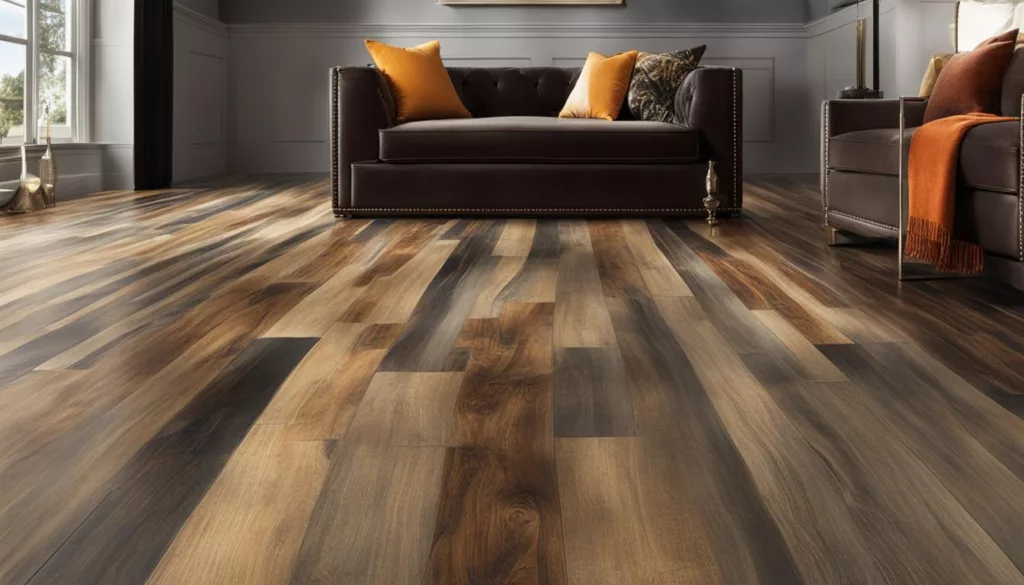
Tip: When selecting floating wood tile for your interior, consider factors such as traffic, moisture, and the desired aesthetic. It is essential to choose the right type of laminate flooring to ensure your space looks beautiful and stays durable for years to come.
Pros and Cons of Laminate Flooring
floating wood tile is a popular choice among homeowners due to its affordability, durability, and easy maintenance. However, like any flooring material, it has its pros and cons that you should consider before making a decision.
Pros of Laminate Flooring
- Affordable: floating wood tile is an excellent value for the money, making it a budget-friendly option for flooring.
- Durable: The multi-layered construction of laminate flooring gives it excellent durability, making it ideal for high-traffic areas.
- Versatile in design: With a wide range of colors, styles, and textures available, floating wood tile can mimic the appearance of more expensive materials like hardwood and stone.
- Easy maintenance: Laminate flooring is simple to clean and doesn’t require any special cleaners or treatments, making it a low-maintenance option for homeowners.
- Resistance to moisture and stains: The clear protective layer on top of the floating wood tile makes it resistant to moisture and stains, making it ideal for areas like kitchens and bathrooms.
Cons of Laminate Flooring
- Limited repair options: Unlike hardwood flooring, it can be challenging to repair damaged floating wood tile, and the damaged plank would need to be replaced entirely.
- Potential moisture damage: While laminate flooring is resistant to moisture if water spills are left unattended for an extended period, they can seep between the planks, causing swelling and damage.
- Not real wood: floating wood tile is not real hardwood, and it can lack the warmth and natural look that some homeowners desire in their homes.
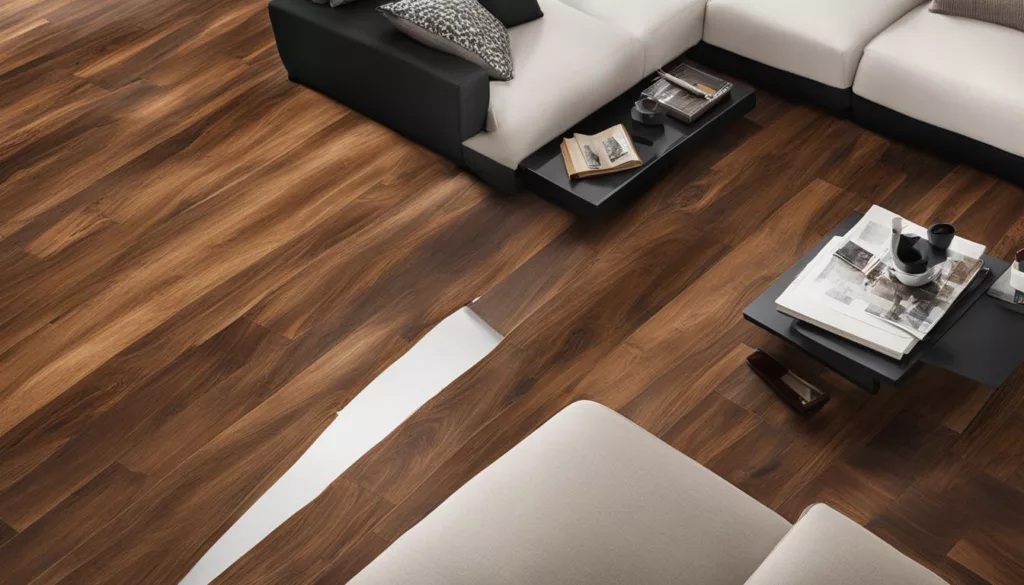
Remember to consider all the pros and cons and think about your specific needs when deciding if laminate flooring is the right option for your home.
Laminate Flooring vs Other Floorings
When choosing a flooring option, it’s important to consider all the alternatives to weigh out the pros and cons. Floating wood tile offers several advantages over traditional floorings like hardwood, vinyl, and carpet.
“Laminate flooring is an excellent alternative to hardwood. Not only is it much more affordable, but it’s also easier to maintain and offers greater durability.”
– Jane Doe, Home Design Expert
One of the primary benefits of floating wood tile is its cost-effectiveness as it tends to be significantly less expensive than hardwood flooring. Laminate flooring also offers greater versatility in terms of style compared to traditional floorings, with a wider range of colors and textures, including options that resemble hardwood, stone, tile, and more. The installation process is also simpler and quicker with floating wood tile, eliminating the need for messy adhesives or sanding.
Additionally, laminate flooring is more durable and resistant to scratches, stains, and moisture damage. Unlike carpet, which can accumulate allergens and bacteria, floating wood tile is hypoallergenic and easy to clean, making it a healthier option for your home.
| floating wood tile | Hardwood | Vinyl | Carpet | |
|---|---|---|---|---|
| Cost | Less expensive | Expensive | Less expensive | Intermediate |
| Installation | Simple, quick | Time-consuming, requires professional installation | Simple, possible DIY installation | Simple, requires professional installation for some options |
| Durability | Durable, resistant to scratches, stains, and moisture | Natural wear and tear, prone to scratches and water damage | Durable, resistant to moisture | Prone to stains, wear and tear, and allergens |
| Maintenance | Easy to clean, hypoallergenic | Requires refinishing, can accumulate allergens and bacteria |
Easy to clean |
Requires regular vacuuming and steam cleaning |
| Aesthetics | Versatile, wide range of styles and colors | Natural look, limited color options | Wide range of colors, limited textures | Wide range of options but limited style choices |
While each flooring option has its advantages and drawbacks, floating wood tile offers a combination of affordability, durability, and versatility, making it an excellent alternative to traditional flooring options. To achieve the look of your desired flooring without breaking the bank, consider floating wood tile as a cost-effective and beautiful option for your home.
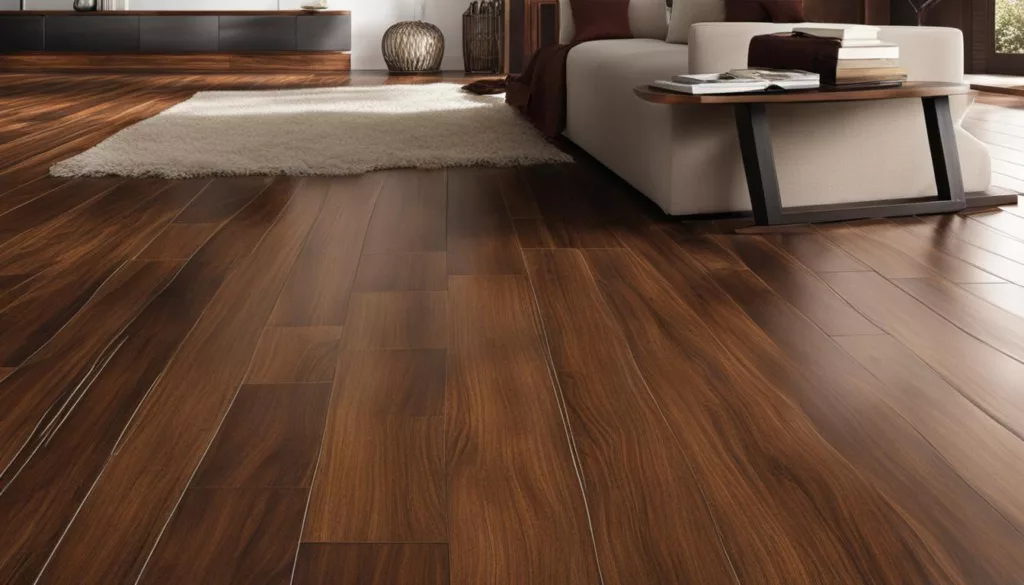
Cost of Laminate Flooring
When considering floating wood tile, it’s essential to understand the associated costs to plan your budget effectively. The cost of laminate flooring can vary depending on several factors, including quality, thickness, brand, and installation requirements.
On average, the cost of floating wood tile can range from $2 to $8 per square foot, including installation fees. Higher-end options such as premium thickness and brands can cost up to $10 per square foot.
Keep in mind that installation costs can vary based on the area’s location and complexity, such as the presence of stairs or unusual corners. Most professionals estimate installation costs based on the area’s size, typically ranging between $1 and $2 per square foot, plus any additional fees for labor or materials.
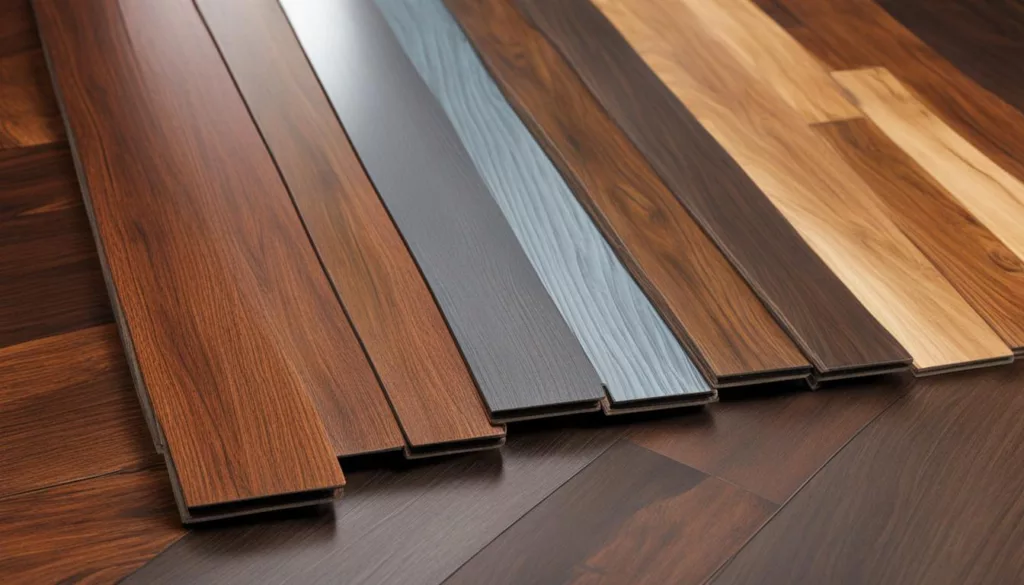
While floating wood tile may seem cheaper compared to other flooring options, remember that quality and durability are also significant factors to consider when investing in your home’s flooring. It’s crucial to evaluate the total cost of laminate flooring and installation, including all additional fees, to ensure the flooring’s long-term value and beauty.
Major Brands in floating wood tile
When it comes to laminate flooring, several reputable brands in the market offer high-quality products for a variety of applications. Here are some major brands to consider:
| Brand Name | Features | Reputation | Customer Reviews |
|---|---|---|---|
| Shaw Floors | Offers a wide range of colors, styles, and textures. Durable and easy to maintain. | Well-established brand known for quality. | Positive reviews for durability and ease of installation. |
|
|
Water-resistant, scratch-resistant, and easy to install. Offers various styles to mimic hardwood and stone. | Known for high-quality products at a reasonable price. | Positive reviews for durability and water resistance. |
| Armstrong Flooring | Offers various styles, designs, and textures. Durable, scratch-resistant, and easy to maintain. | Well-known brand with a reputation for quality. | Positive reviews for durability, variety, and ease of installation. |
You can also consider other reputable brands such as Mohawk, Mannington, and Quick-Step. It’s essential to research different brands thoroughly, read customer reviews, and check their reputation before making a purchase. This information will assist you in finding reliable and trusted brands to consider when purchasing laminate flooring.
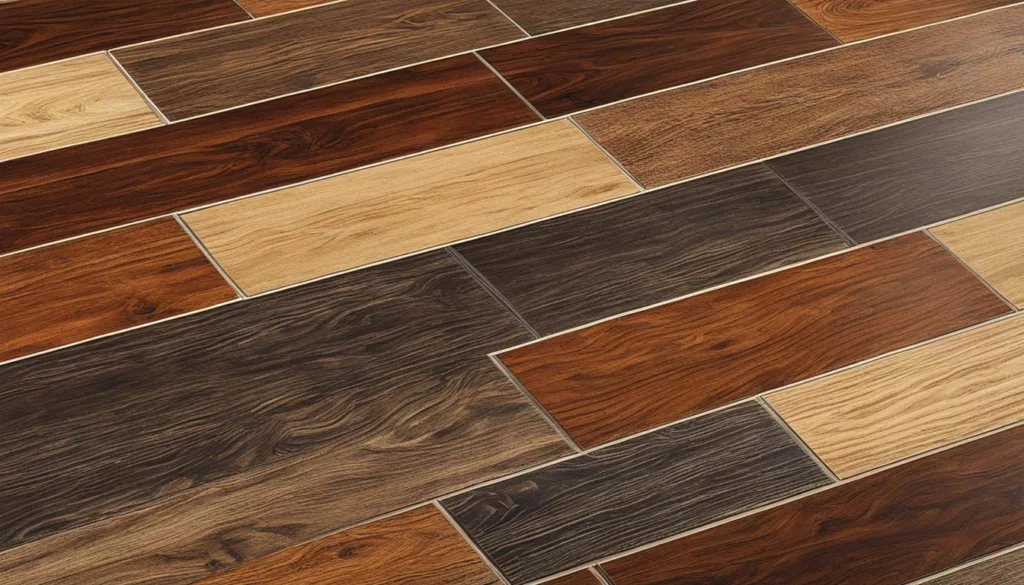
Key Takeaways
As a recap of what we’ve covered throughout the article, here are the key takeaways to keep in mind when considering floating wood tile:
- Laminate flooring is a durable and cost-effective alternative to hardwood and stone flooring.
- It comes in various types, including decorative, industrial, and textured laminates.
- When choosing laminate, consider factors such as thickness, AC rating, style, and color, as well as the specific area where it will be installed.
- floating wood tile is easy to maintain, moisture-resistant, and available in a wide range of designs.
- Some major brands to consider when shopping for laminate flooring are Pergo, Mohawk, and Quick-Step.
- While laminate flooring has its advantages, it also has some drawbacks, such as limited repair options and potential moisture damage.
- When comparing floating wood tile to other options, such as hardwood, vinyl, and carpet, consider factors such as cost, durability, and maintenance.
- The cost of laminate flooring varies based on quality, thickness, brand, and installation requirements.
- Proper installation is crucial for the longevity and durability of floating wood tile.
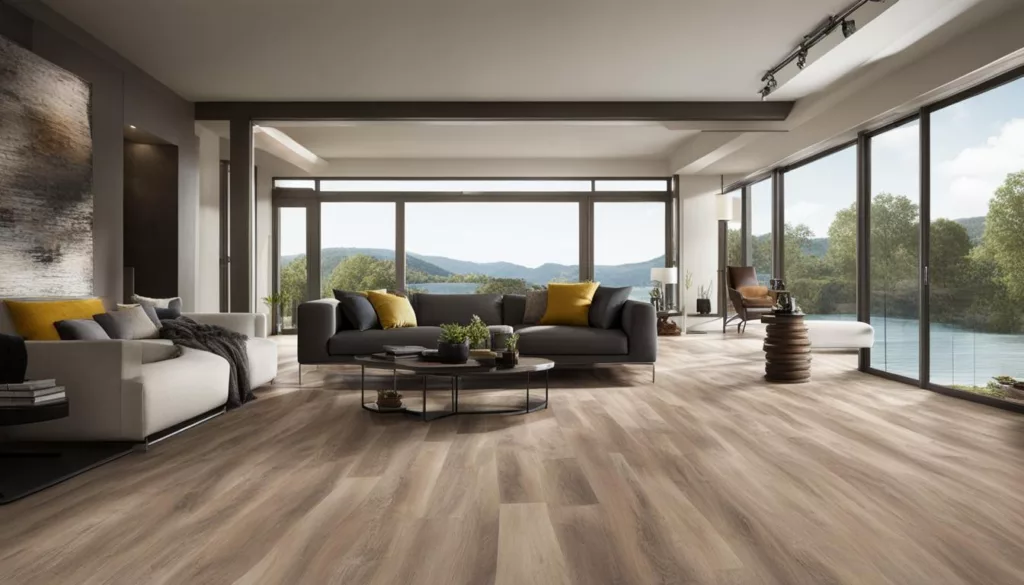
Remember these key takeaways as you make important decisions about your flooring options. A thorough understanding of the types, pros and cons, and costs associated with laminate flooring will help you choose the right option for your specific needs.
Conclusion
In conclusion, choosing the right flooring for your space can be a daunting task, but laminate flooring offers a versatile and cost-effective solution. Throughout this guide, you have gained a clear understanding of what floating wood tile is, the different types and styles available, as well as the benefits and drawbacks. You have also learned about the factors to consider when choosing laminate flooring, including thickness, AC rating, and colors.
It’s important to remember that floating wood tile is not the perfect fit for all situations, and it’s always advised to weigh the pros and cons when making a decision. Comparing laminate flooring to other popular flooring options such as hardwood, vinyl, and carpet can also help you understand its unique features and benefits.
Remember to factor in the cost of floating wood tile when planning your budget, and always seek out trusted and reputable brands for your purchase. With the right selection and proper installation, floating wood tile can provide a beautiful and durable floor for many years to come.
FAQ
Is floating wood tile a good idea?
Yes, floating wood tile is a popular choice for many homeowners due to its durability, affordability, and versatility in design. It offers a cost-effective alternative to hardwood or stone flooring.
What is the benefit of floating wood tile?
Laminate flooring offers several benefits, including durability, easy maintenance, resistance to scratches and stains, and a wide variety of design options. It is also more affordable compared to other flooring materials.
How many types of laminate flooring are there?
There are several types of floating wood tile available, including decorative laminates, industrial laminates, compact laminates, high-pressure laminates, low-pressure laminates, and textured laminates. Each type has its own characteristics and ideal applications.
How to choose a laminate?
When choosing a laminate, consider factors such as thickness, AC rating, style, colors, and the specific area where you plan to install the flooring. These considerations will help you select the most suitable option for your needs.
Thanks For the Great Attention!
Also, Read,
Wall Mounted vs Floor Mounted Toilets
Flush Door vs Wooden Panel Door
UPVC vs Aluminium vs Wooden Windows
Gypsum Plaster vs Cement Plaster


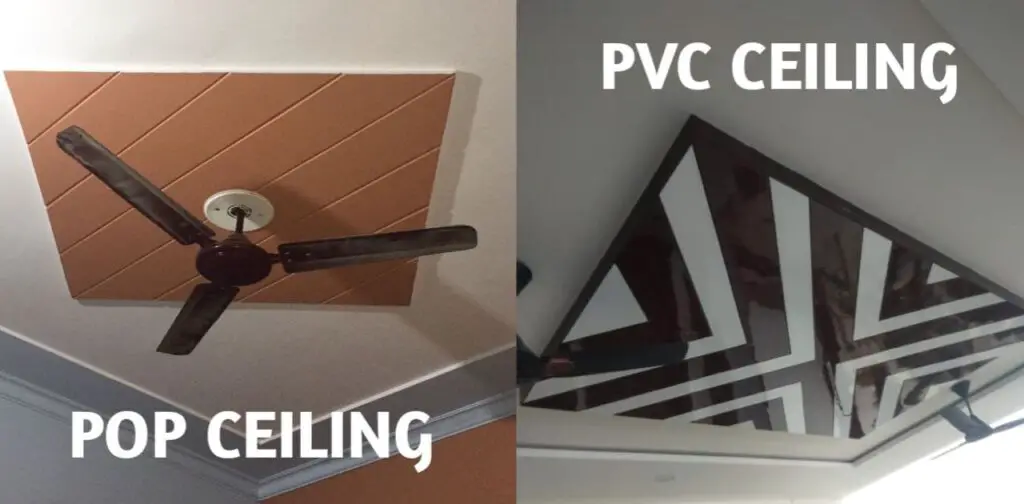

Pingback: Guide: How to choose a laminate Flooring Successfully
Pingback: 3 Ultimate Benefits of Laminate Flooring for Homes